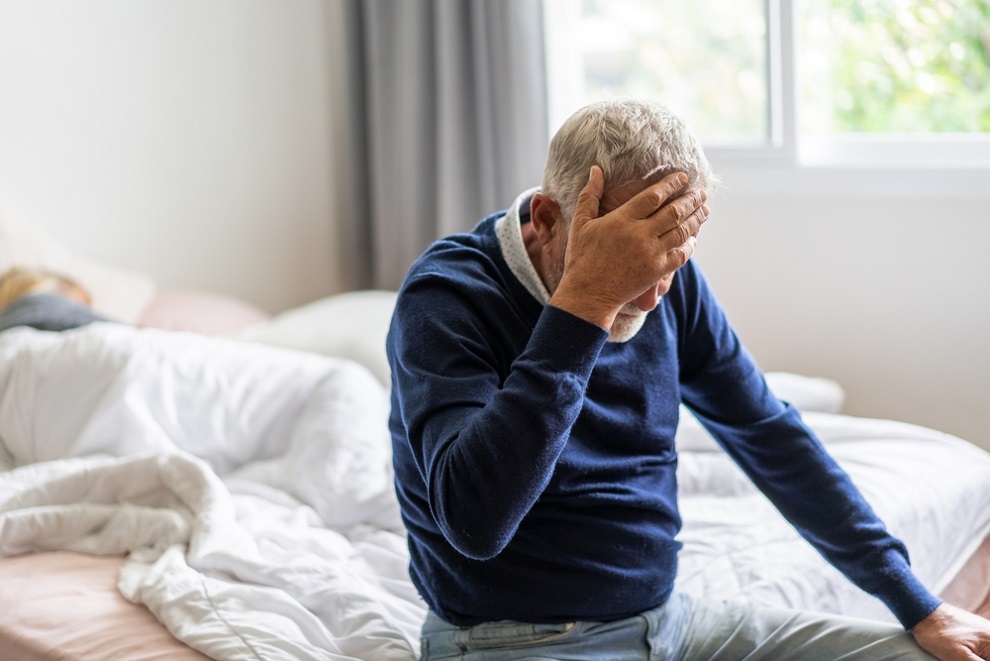Does your groin area itch in a way that's hard to ignore and even harder to talk about? You're not alone. About 20% of people worldwide deal with fungal skin infections, including jock itch.
It's not just an uncomfortable experience but also deeply embarrassing, especially when the itching strikes in public or during important moments. The groin area is particularly sensitive, making it a hotspot for skin irritations and fungal infections that cause itchy rashes.
This persistent issue can interfere with your day-to-day activities and even chip away at your confidence. This blog dives into the most common causes of an itchy crotch, the symptoms you should be aware of, and how to keep the problem from returning.

What is Jock Itch?
Jock itch, also called tinea cruris, is a fungal infection that targets the groin area, including the upper thighs and buttocks. While it's more common among athletes or those who sweat a lot, it can affect anyone.
The condition starts when fungi, known as dermatophytes, grow on the upper layers of the skin. These fungi thrive in warm, damp places, which makes the groin area a prime target.
Jock itch symptoms often include a red, itchy rash with a clear edge that spreads to the inner thighs. The infection spreads easily through direct contact, shared towels, or clothing that hasn't been washed properly.
How Jock Itch Spreads?
Jock itch spreads easily through direct contact with an infected person or surface. Skin-to-skin contact, especially during physical or sexual activities, is a common way the fungus transfers.
Sharing personal items like towels, clothing, or bedding with someone who has a jock itch can also cause infection. The fungus responsible for jock itch, dermatophyte, can travel from other infected areas of your body.
For example, if you have an athlete's foot (tinea pedis), you can spread the fungus to your groin by touching your feet and then your groin. It can also transfer through clothing. Putting on underwear after socks, especially if the socks have been in contact with infected feet, increases the risk of spreading the infection.
Symptoms of Jock Itch
Jock itch typically starts with a red, itchy rash that can be painful, often stinging or burning. It usually begins in the groin and spreads in a half-moon shape onto the upper thigh.
The skin may become scaly and flaky, and small bumps or blisters may develop as the infection worsens. The discomfort can worsen with sweat or friction. In some cases, an itchy crotch can also cause a decrease in libido, as the irritation and discomfort may affect sexual health and desire.
The rash can cause significant irritation and pain, especially when aggravated by sweating or friction. It also spreads through direct skin-to-skin contact with an infected person or by sharing personal items. Even touching infected surfaces can put you at risk.
Causes of Jock Itch
Jock itch is a common fungal infection, but it's not the only cause of an itchy groin. Below are some of the potential reasons behind itchy crotch:
Sexually Transmitted Infections (STIs)
Certain STIs, such as herpes and chlamydia, cause itchy rash and irritation in the groin area. These conditions may also cause blisters, discharge, and painful sores. It's important to consult a doctor if you suspect an STI, as timely treatment can prevent complications.
Yeast Infection
Yeast infections are commonly linked to women, but they can also occur in men, especially in the groin area. Studies show that nearly 75% of women will be affected with a yeast infection at some point, indicating the commonality of this condition.
In men, an overgrowth of Candida yeast can cause itching, redness, erectile dysfunction and a noticeable rash. Factors such as excessive moisture, wearing tight clothing, or having a weakened immune system often contribute to its development.
Allergic Reactions
Allergic reactions to detergents, fabrics, or personal care products like feminine hygiene sprays, scented panty liners or vaginal douches can cause genital itch in the groin area. Symptoms often include itching, redness, and a rash that improves once the irritant is removed.
Lichen Planus
It is an inflammatory skin condition that causes purplish, itchy bumps. It can affect various parts of the body, including the groin, vagina, vulva, and anus. Although the precise reason is unclear, it is thought to be linked with the functioning of the immune system.
Pinworms
Pinworm infestations, though more common in children, can also affect adults. These tiny parasites cause intense itching, particularly at night, around the groin and anal areas. Treatment typically involves oral medication to eliminate the worms.
Diagnose of Jock Itch
A doctor diagnoses jock itch by KOH examination of the rash and asking about your symptoms and lifestyle.
The appearance of the rash, combined with your history of sweating, tight clothing, or athletic activities, can help a healthcare provider make a quick diagnosis. Sometimes, the health care provider may scrape off a small sample of the infected skin to examine it under a microscope or send it to a lab for further testing. This helps confirm the presence of the fungal infection and rule out other conditions that may appear similar.
While a visual examination is often enough, a biopsy might be necessary if the infection is particularly stubborn or if there is any doubt about the diagnosis. For itchy crotch men, getting a diagnosis is the first step toward effective treatment. With these steps, your doctor can guide you toward the best treatment plan for your case and provide relief.

Treatment Options for Jock Itch
If you're dealing with a jock itch, over-the-counter (OTC) antifungal creams, sprays, or powders are often the first line of defense. These can include Clotrimazole, Miconazole, Terbinafine or Tolnaftate.
These can work well if the infection is mild, helping to clear it up fairly quickly. For more severe cases, prescription treatments like econazole or oxiconazole in topical form and fluconazole or itraconazole in pill form might be necessary. Some doctors also recommend a combination of antifungal medication with a mild corticosteroid to tackle the fungus and any swelling.
In any case, treat jock itch promptly to prevent the infection from spreading or worsening. OTC treatments are often enough for mild cases, but more stubborn infections may need the attention of a healthcare professional. Follow the treatment instructions carefully and continue using antifungal products for the recommended duration, even if symptoms improve before treatment ends.
If jock itch has been affecting your sexual health or causing discomfort during intimacy, it may be worth addressing related concerns such as erectile dysfunction. Consider looking into options like Malexcel's Generic Viagra, which may help manage erectile dysfunction alongside treating jock itch. However, always consult with a healthcare expert before starting any medications.
Home Remedies for Fungal Infection
For mild cases of jock itch, some home remedies can help stop the fungal infection. Rubbing alcohol can prevent fungal growth on the skin's surface.
It works by drying out the affected area, making it harder for the fungi to spread. Essential oils, such as tea tree, peppermint, and eucalyptus, have antifungal properties that can also help mitigate the discomfort. These oils may not eliminate the infection but can assist in managing symptoms and reducing irritation.
Garlic is another option. It contains a compound called ajoene, which has been shown to prevent or stop bacterial growth. While garlic and essential oils can offer relief, they may not fully cure the infection.
It's important to note that these remedies are best suited for mild infections. If symptoms persist or worsen, seek medical treatment immediately.
Managing and Preventing Jock Itch
Maintaining good hygiene and creating an environment that discourages fungal growth and discourages jock itch. Below are some effective tips to prevent itchy crotch:
Keep Your Groin Dry, Clean, and Cool
Fungi thrive in warm, moist areas, so keeping the genital area dry is the first line of defense.
After showering, thoroughly dry your body, especially in the inner thighs and groin areas. Use talcum or antifungal powder if you live in a humid or hot climate or engage in physical activities that make you sweat a lot. This helps absorb moisture, making it harder for the fungus to grow.
Wear Loose, Cotton Clothing
Tight-fitting clothes trap sweat and moisture close to your skin. This creates a perfect environment for fungi to grow.
Switch to loose-fitting, breathable clothing. Cotton underwear is the best option since it promotes airflow and wicks away moisture, which helps to avoid the accumulation of dampness that can result in fungal infections.
Avoid Scratching
It might be tempting, but scratching the affected area can worsen the infection by spreading the fungus to other body parts. Instead, use an antifungal cream to treat the area and relieve itching. If your infection persists, consult a doctor for further treatment.
Maintain Good Hygiene
Daily bathing is vital. Make sure to clean your body thoroughly, focusing on the groin area. Avoid sharing personal items, such as razors, towels, or clothing, to prevent spreading the infection. Change clothes every day and promptly change out of sweaty clothes after each exercise session.
Use Separate Towels
Sharing towels or using the same towel for multiple body areas can spread fungi. Have a dedicated towel for your groin area, and wash it regularly.
Other Prevention Tips
If you're prone to jock itch, avoid staying in wet clothing, such as a damp bathing suit, for too long. When possible, take a shower after swimming. Fungi can also thrive in public spaces like gyms, so wear flip-flops in locker rooms and showers.
Who Is More Likely to Develop Jock Itch?
Jock itch often affects athletes who sweat heavily and wear tight, damp clothing for extended periods.
Men and teenage boys are more prone to this condition because moisture can easily become trapped between the thighs and scrotum, creating an ideal environment for fungal growth. People who are overweight are also at higher risk, as skin folds tend to retain heat and sweat, encouraging fungal infections.
That said, jock itch isn't limited to these groups. It can affect anyone since it spreads easily through contact with infected surfaces, shared towels, or clothing.
When to Seek Medical Attention
Jock itch is often manageable with over-the-counter remedies and home care, but there are instances when medical help is necessary.
If you experience severe symptoms, such as intense itching, burning, or persistent pain, it's time to consult a healthcare professional. These symptoms could indicate a more serious fungal infection or another underlying condition requiring targeted treatment.
Individuals with a weakened immune system, such as those undergoing chemotherapy or taking immune-suppressing medications, are at greater risk of complications from fungal infections. In such cases, seeking medical attention at the earliest sign of jock itch is vital.
Recurrent fungal infections or a history of chronic jock itch might signal an underlying condition that needs further investigation. Additionally, if you're unsure whether your symptoms are due to jock itch or another skin issue, such as psoriasis or an allergic reaction, a doctor's evaluation can provide clarity.
According to a study, fungal skin conditions become resistant to treatment due to delays in seeking care. So, seek prompt medical advice to ensure appropriate care and minimize the risk of spreading this infection to others.
Conclusion
Jock itch is a fungal skin infection that affects the groin and surrounding areas. While it can be uncomfortable, it's usually manageable with proper care.
Mild cases can be treated with OTC antifungal creams or sprays, but more persistent infections might need prescription medication. You can prevent itchy crotch by maintaining good hygiene, wearing breathable clothing, and avoiding moisture buildup in the groin area.
If symptoms persist or worsen, consult medical help immediately. Take action early to manage the condition and prevent it from spreading. A healthcare professional can provide an accurate diagnosis and recommend the most effective treatment, helping to prevent complications and promote faster healing.





